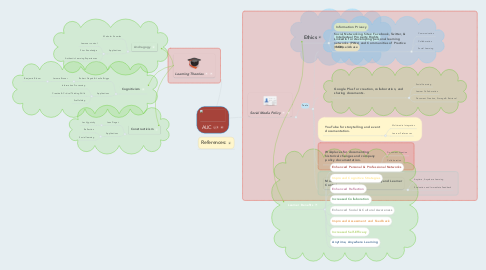
1. Learning Theories
2. Andragogy
2.1. Malcolm Knowles
2.2. Applications
2.2.1. Learnner control
2.2.2. Prior Knowledge
2.2.3. Authentic Learning Experiences
3. Cognitivism
3.1. Robert Gagné & Leslie Briggs
3.1.1. Jerome Bruner
3.1.1.1. Benjamin Bloom
3.2. Applications
3.2.1. Information Processing
3.2.2. Creative & Critical Thinking Skills
3.2.3. Scaffolding
4. Constructivism
4.1. Jean Piaget
4.1.1. Lev Vygotsky
4.2. Applications
4.2.1. Reflection
4.2.2. Social learning
5. References:
6. Ethics
6.1. Information Privacy
6.2. Intellectual Property Rights
6.3. Misuse/Abuse
7. Social Media Policy
7.1. Tools
7.1.1. Social Networking Sites: Facebook, Twitter, & LinkedIn for developing personal learning networks (PLNs) and Communities of Practice (COP)
7.1.1.1. Communication
7.1.1.2. Collaboration
7.1.1.3. Social Learning
7.1.2. Google Plus for creation, collaboration, and sharing documents.
7.1.2.1. Social Learning
7.1.2.2. Learner Collaboration
7.1.2.3. Document Creation, Storage & Retrieval
7.1.3. YouTube for storytelling and event documentation.
7.1.3.1. Multimedia Integration
7.1.3.2. Learner Preferences
7.1.4. Wikiplaces for documenting historical changes and company policy documentation.
7.1.4.1. Document Creation
7.1.4.2. Collaboration
7.1.5. Moodle LMS for Independent Study and Learner Control
7.1.5.1. Anytime, Anywhere Learning
7.1.5.2. Evaluation and Immediate Feedback
